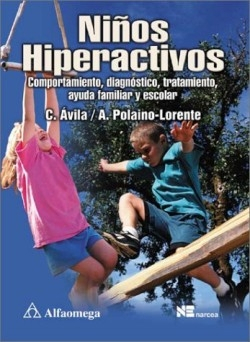Nios Hiperactivos
Comportamiento Diagnostico Tratamiento Ayuda Familiar y Escolar
On a primary school field trip to the zoo, David, age six, lets go his companion’s hand, jumps over the retaining wall and flings himself into the pool where the seals are being fed. Oscar is in third grade, but when reading aloud he skips letters and even some whole words, and has no idea what he has just read; Ana, a tiny seven-year-old, charms strangers with her sweet smile and angelic face, but Mama can’t get her to help around the house, and her Papa and brothers complain that she takes their things without permission and then can’t remember where she left them. In school, she is always the first to raise her hand, but never knows the answer. She makes friends easily, and loses them even more easily.
The authors are both graduates of Spain’s University of Madrid; Ãvila has a Ph.D. in education and Polaino-Lorente has a Ph.D. in medicine and is a specialist in pathology and childhood disorders. They have collaborated on this handy book dealing with hyperactive children and the escalating prevalence of Attention Deficit Disorder. The first chapter outlines some of the obvious signs of these conditions, using as a model copious selections from Tom Sawyer. The examples, from actual clinical experience, are engaging, clearly diagnostic, and easy to understand. Anyone who has parented, taught, or even been acquainted with children with these disorders will recognize them.
The book’s chapters advance from simple observation, through diagnostic signs and advice for both parents and teachers, to solutions for the recognition and remediation of a common problem (an estimated three to five per cent of the juvenile population) that can look hopeless, but is actually solvable. Chapter headings include: What Is Childhood Hyperactivity? What Are the First Signs? What To Do if Parents Suspect that Their Child is Hyperactive? Solutions; and end with sample tests. A number of black-and-white photos and charts enhance the legibility of the text, and a glossary of medical terms is included.
These disorders, which can present grave dangers if misunderstood or overlooked, can be treated and resolved if detected before a child has compensated with even more irregular behavior. Advances in both psychological analysis and clinical practice are now offering new hope for the old, familiar problem of what makes a child a “brat.” Although books on the topic are increasingly prevalent in English, this Spanish study should be of enormous help to both parents and teachers in the Hispanic communities of both hemispheres.
Reviewed by
Sandy McKinney
Disclosure: This article is not an endorsement, but a review. The publisher of this book provided free copies of the book to have their book reviewed by a professional reviewer. No fee was paid by the publisher for this review. Foreword Reviews only recommends books that we love. Foreword Magazine, Inc. is disclosing this in accordance with the Federal Trade Commission’s 16 CFR, Part 255.

